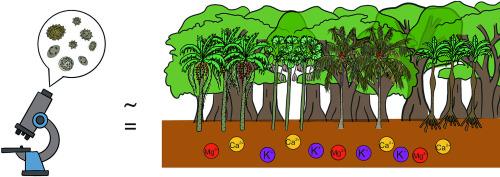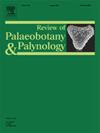Soil phytolith assemblages reflect palm community composition in western Amazonia
IF 1.7
3区 地球科学
Q2 PALEONTOLOGY
引用次数: 0
Abstract
Humans have domesticated and used palms in tropical forests for millennia. The extent to which past human palm use affects modern tropical systems remains relatively unexplored due to lack of a good fossil record. However, palms produce an array of phytoliths, which are siliceous cell structures that preserve well in the soil even after the organic plant material has decayed. Phytoliths vary in morphology and can be identified to group level and sometimes even to species. We analyzed if palm phytolith assemblages sampled from the soil reflect palm species compositions and abundances in 63 western Amazonian transects. Principal coordinate analysis (PCoA) and Mantel tests showed that palm communities and phytolith assemblages had similar turnover patterns. Negative binomial generalized linear models indicated that the abundances of nine of the 13 common palm genera were significantly related to a combination of soil cation concentrations, grass phytolith percentages, and palm phytolith PCoA axis scores. These results suggest that phytoliths have potential as quantitative indicators of changes in palm abundances in paleoecological and archaeological reconstructions.

西部亚马逊地区土壤植物岩组合反映了棕榈群落组成
几千年来,人类一直在热带森林中驯化和使用棕榈树。由于缺乏良好的化石记录,过去人类使用棕榈树对现代热带系统的影响程度仍然相对未被探索。然而,棕榈树会产生一系列植物岩,这是一种硅质细胞结构,即使在有机植物物质腐烂后,它们也能很好地保存在土壤中。植物岩在形态上各不相同,可以在群水平上识别,有时甚至可以在种水平上识别。我们分析了63个亚马逊西部样带的棕榈植物岩组合是否反映了棕榈物种的组成和丰度。主坐标分析(PCoA)和Mantel试验表明,棕榈群落和植物岩组合具有相似的更替模式。负二项广义线性模型表明,13个常见棕榈属中有9个属的丰度与土壤阳离子浓度、草植体百分比和棕榈植体PCoA轴评分的组合呈显著相关。这些结果表明,植物岩具有作为古生态和考古重建中棕榈丰度变化的定量指标的潜力。
本文章由计算机程序翻译,如有差异,请以英文原文为准。
求助全文
约1分钟内获得全文
求助全文
来源期刊
CiteScore
3.50
自引率
21.10%
发文量
149
审稿时长
6 months
期刊介绍:
The Review of Palaeobotany and Palynology is an international journal for articles in all fields of palaeobotany and palynology dealing with all groups, ranging from marine palynomorphs to higher land plants. Original contributions and comprehensive review papers should appeal to an international audience. Typical topics include but are not restricted to systematics, evolution, palaeobiology, palaeoecology, biostratigraphy, biochronology, palaeoclimatology, paleogeography, taphonomy, palaeoenvironmental reconstructions, vegetation history, and practical applications of palaeobotany and palynology, e.g. in coal and petroleum geology and archaeology. The journal especially encourages the publication of articles in which palaeobotany and palynology are applied for solving fundamental geological and biological problems as well as innovative and interdisciplinary approaches.

 求助内容:
求助内容: 应助结果提醒方式:
应助结果提醒方式:


